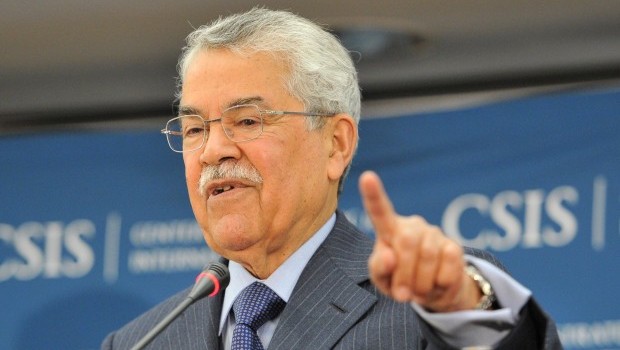
Saudi Arabian minister of petroleum and mineral resources Ali Ibrahim Al-Naimi addresses the audience during a lecture at the Center for Strategic and International Studies (CSIS) in Washington, D.C. on April 30, 2013. (AFP PHOTO/ Mladen ANTONOV)
Naimi stressed that Saudi Arabia does not want to see a rise in oil prices, except where this reflects actual market conditions: “In 2012, I came out and called for lower oil prices…. I stressed to the media and others that supply fears were unfounded and that the current prices were not a true reflection of supply–demand fundamentals.”
Making reference to the the peak oil crisis of 2009, Naimi criticized experts who predicted that the world was running out of oil and predicted a shift to other energy sources.
The Saudi oil minister also criticized the idea of energy independence as “naïve” and “simplistic,” predicting that increasing oil production in the US will not mean the end of US oil imports from Saudi Arabia or of US involvement in world affairs. He said that such suggestions “seem to conflate, on the one hand, US foreign policy, and on the other, US energy policy.”
Naimi pointed out that Saudi Arabia had increased production in response to world crises, citing Hurricane Katrina, labor disputes in Venezuela, and the Libyan revolution as examples. Arguing that “only Saudi Arabia has the capacity and the ability to take steps such as these,” he pointed to the 2.5–3.5 million barrels of additional capacity that Saudi Arabia has carried since 2009, stating that this was an expensive but necessary precaution for the Gulf kingdom to take.
Welcoming the development of shale oil and tight oil by the US, Naimi said: “I hope these additional resources will add depth and bring increased stability to global oil markets.”
On his own country’s shale oil reserves, he said that further technological innovation and infrastructure is required before this resource can be developed to its full potential, due to the differing rock formations the oil is held in: “We believe we have tremendous volumes of shale oil. What we need to figure out is how to develop it.”
While optimistic about Saudi Arabia’s economic prospects, the minister outlined the challenges facing further development in the Saudi energy sector, including tackling energy inefficiency and developing renewable energy projects. He stressed that while the kingdom is diversifying away from its reliance on oil, the sector has been largely responsible for Saudi development over the past sixty years.
Naimi noted that Saudi Arabia is in an excellent position to develop solar energy, and that it has invested in ongoing projects to increase output. He spoke in particular of the new solar energy center at King Abdullah University of Science in Technology, which is part of the Saudi effort to make solar energy and substantial part of its energy sector.
In response to a question about the rise of East Asia, and India and China in particular, Naimi said that today, “about 70 percent of [Saudi oil] exports go to Asia—not only to China, but India, Korea, Japan, and we have big interests in both China, Korea and Japan. We’re also supplying India, Indonesia, Thailand—[you] name it—in Asia.” This marks a shift in export destinations, as historically the majority of Saudi oil exports went to the US and Europe.

Trackbacks/Pingbacks